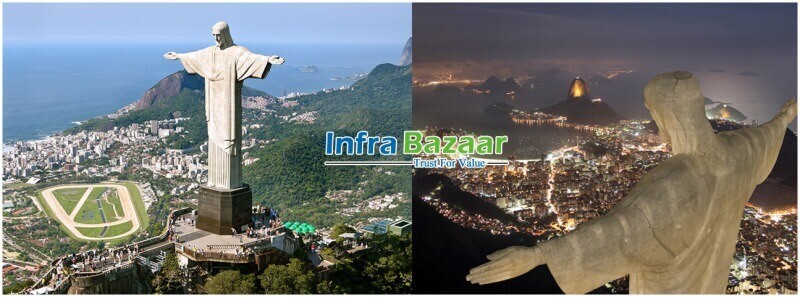
Posted By:Infra Bazaar
Christ the Redeemer is an Art Deco statue of Jesus Christ in Rio de Janeiro, Brazil, created by French sculptor Paul Landowska and built by the Brazilian engineer Heitor da Silva Costa, in collaboration with the French engineer Albert Caquot. It is 30 meters tall, not including its 8-metre pedestal, and its arms stretch 28 meters wide. The statue weighs 635 tons and is located at the peak of the 700-metre Corcovado Mountain in the Tijuca Forest National Park overlooking the city of Rio. As a symbol of Brazilian Christianity, the statue has become an icon for Rio de Janeiro and Brazil. It is made of reinforced concrete and soapstone and was constructed between 1922 and 1931.
In the 1850s the Vincentian priest, Pedro Maria Boss suggested placing a Christian monument on Mount Corcovado to honour Isabel, princes's regent of Brazil and the daughter of Emperor Pedro II, although the project was never approved. In 1921 the Roman Catholic Archdiocese of Rio de Janeiro proposed that a statue of Christ be built on the 2,310-foot (704-metre) summit, which, because of its commanding height, would make it visible from anywhere in Rio. Citizens petitioned Pres. Epitácio Pessoa to allow the construction of the statue on Mount Corcovado.
The exact dimensions of Christ the Redeemer statue in Rio de Janeiro are as follows: the height of the figure is 38 meters, the height of the pedestal — 8 meters, weight — 1145 tons, arm stretch — 30 meters. It is believed that the idea behind the creation of the statue came up in 1922, on the 100th anniversary of Brazil's independence. It appears that the story of the statue goes with its roots deep in the past.
Back in 1859 a Catholic priest Pedro Maria Boss was struck by the majestic beauty of the mountain of Corcovado while visiting Brazil. It was he who proposed to build a monument to Christ on top of the mountain. But at that time his aspirations were hard to accomplish: first the Brazilian Court had no money, and then the monarchy was replaced by the republican government. And since the church was legally separated from the state, the idea of building a monument was forgotten.
The mountain was too striking to be empty, and in the XXth century, Catholic organizations of Rio de Janeiro raised the issue again. Signatures were collected, funds were raised and, as a result, this ambitious project was able to get more than 2 million real’s ($250,000), a huge amount of money for that time.
Permission was granted, and the foundation stone of the base was ceremonially laid on April 4, 1922—to commemorate the centennial on that day of Brazil’s independence from Portugal—although the monument’s final design had not yet been chosen. That same year a competition was held to find a designer, and the Brazilian engineer Heitor da Silva Costa was chosen on the basis of his sketches of a figure of Christ holding a cross in his right hand and the world in his left. In collaboration with Brazilian artist Carlos Oswald, Silva Costa later amended the plan; Oswald has been credited with the idea for the figure’s standing pose with arms spread wide. The French sculptor Paul Landowska, who collaborated with Silva Costa on the final design, has been credited as the primary designer of the figure’s head and hands. Funds were raised privately, principally by the church. Under Silva Costa’s supervision, construction began in 1926 and continued for five years. During that time materials and workers were transported to the summit via railway.
After its completion, the statue was dedicated on October 12, 1931. Over the years it has undergone periodic repairs and renovations, including a thorough cleaning in 1980, in preparation for the visit of Pope John Paul II to Brazil that year, and a major project in 2010, when the surface was repaired and refurbished. Escalators and panoramic elevators were added beginning in 2002; previously, in order to reach the statue itself, tourists climbed more than 200 steps as the last stage of the trip. In 2006, to mark the statue’s 75th anniversary, a chapel at its base was consecrated to Our Lady of Aparecida, the patron saint of Brazil.
#ChristTheRedeemer #RioDeJaneiro #ArtDeco #BrazilianChristianity #PaulLandowska #HeitorDaSilvaCosta #CorcovadoMountain #TijucaForestNationalPark #Catholicism #PedroMariaBoss #PedroII #OurLadyOfAparecida